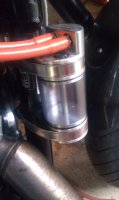fossilrider
Tuned and Synch'ed
Hey folks,I need some input from anyone who has been through this.I'm currently getting two T3s going,one I am cafe-ing the other will be stock.Problem is I want to simplify the tangle of hoses that vent everything.I have two of the vent canisters off 850Ts,which are much smaller and neater than the unit for the T3.I am modifying the "Y" tube where the vents from the valve covers connect so the hoses can run straight from the outlet on the valve cover to a "T attached where the "Y" was cut off(the "Y" was pointed in the wrong direction so the hoses had to sweep way around to line up or they would kink).This is going to work fine for the stock bike and it will tidy up the area between the carbs.(Forgot to mention,I'm useing K&N pods on both bikes).For the cafe,though,I would still like to do away with more since I am useing a smaller battery and have moved the electrics up under the seat and will use no side panels.Has anyone found small individual"pod-type" breathers that would work for this? Any help greatly appreciated.Steve

